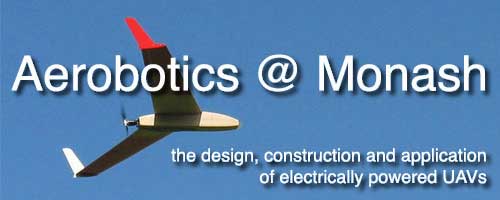Radio Control
The primary radio control links are based on
JR PCM equipment operating
at 36MHz.
Failsafe
The failsafe VHF beacon uses Radiometrix
RF Modules. Loss of the beacon signal for any reason for a
period longer than 2.5s will terminate the flight. The nominal
range of this Beacon is 10Km.
For some test flights within line of sight we
do not use the VHF Beacon. In these cases failsafe is triggered
by the loss of RC transmissions for more than 1.5s.
The failsafe monitoring circuits are independent
of the autopilot and use separate power sources sufficient
to trigger parachute
release mechanisms. The purpose of the parachute is to limit
kinetic energy not as an aircraft recovery mechanism.
See also the overview
paper .
Data Telemetry
Date telemetry is at 900MHz using a MaxStream
modems. The nominal range of this equipment is 32Km.
Video Telemetry
Video Telemetry is at 2.4GHz. The nominal range
of the link is 1Km with patch antenna built by Ray Cooper
or greater with a tracking
antenna [YouTube] (paper)developed
by Stewart Jenvey
and visiting researchers. Stewart's interests extend to all
aspects of RF design and avionics.
Cameras
Currenty we use the Pentax Optio series of cameras
because of their low mass and ability to stream video. The
camera is remotely operated by synthesising Pentax commands
and coupling them to the camera remote control system using
opto-couplers.
We also use a variety of simple steerable card
cameras largely for viewing airframe performance (airflow,
parachute release, control surface operation etc.).
Most of the early work on camera systems and
telemetry was peformed by Terry Cornall and Ray Cooper. Terry
continued to be a driving force on video telemetry and other
camera based techniques.
Other
See our publications
for other avionics related research and some examples
of components supporting the avionics.
Return to Aerobotics

